ignition MAZDA MODEL 3 HATCHBACK 2020 Owners Manual (in English)
[x] Cancel search | Manufacturer: MAZDA, Model Year: 2020, Model line: MODEL 3 HATCHBACK, Model: MAZDA MODEL 3 HATCHBACK 2020Pages: 598, PDF Size: 89.37 MB
Page 27 of 598
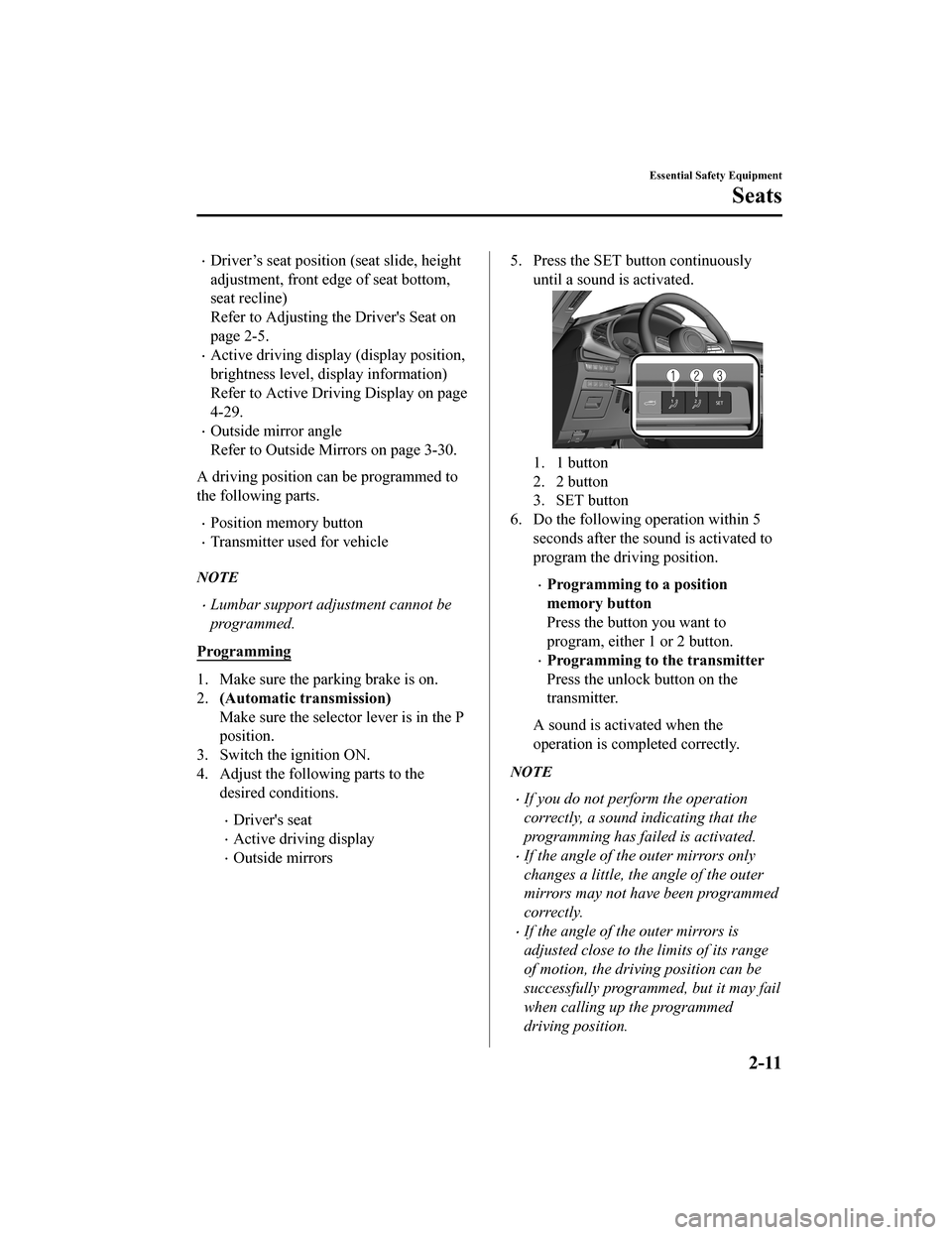
Driver’s seat position (seat slide, height
adjustment, front edge of seat bottom,
seat recline)
Refer to Adjusting the Driver's Seat on
page 2-5.
Active driving display (display position,
brightness level, display information)
Refer to Active Driving Display on page
4-29.
Outside mirror angle
Refer to Outside Mirrors on page 3-30.
A driving position can be programmed to
the following parts.
Position memory button
Transmitter used for vehicle
NOTE
Lumbar support adjustment cannot be
programmed.
Programming
1. Make sure the parking brake is on.
2. (Automatic transmission)
Make sure the selector lever is in the P
position.
3. Switch the ignition ON.
4. Adjust the follo wing parts to the
desired conditions.
Driver's seat
Active driving display
Outside mirrors
5. Press the SET button continuously until a sound is activated.
1. 1 button
2. 2 button
3. SET button
6. Do the following operation within 5 seconds after the sound is activated to
program the driving position.
Programming to a position
memory button
Press the button you want to
program, either 1 or 2 button.
Programming to the transmitter
Press the unlock button on the
transmitter.
A sound is activated when the
operation is completed correctly.
NOTE
If you do not perform the operation
correctly, a sound indicating that the
programming has failed is activated.
If the angle of the outer mirrors only
changes a little, the angle of the outer
mirrors may not have been programmed
correctly.
If the angle of the outer mirrors is
adjusted close to the limits of its range
of motion, the driving position can be
successfully programmed, but it may fail
when calling up the programmed
driving position.
Essential Safety Equipment
Seats
2-11
Mazda3_8HZ1-EA-19G_Edition1_old 2019-5-17 13:49:03
Page 28 of 598
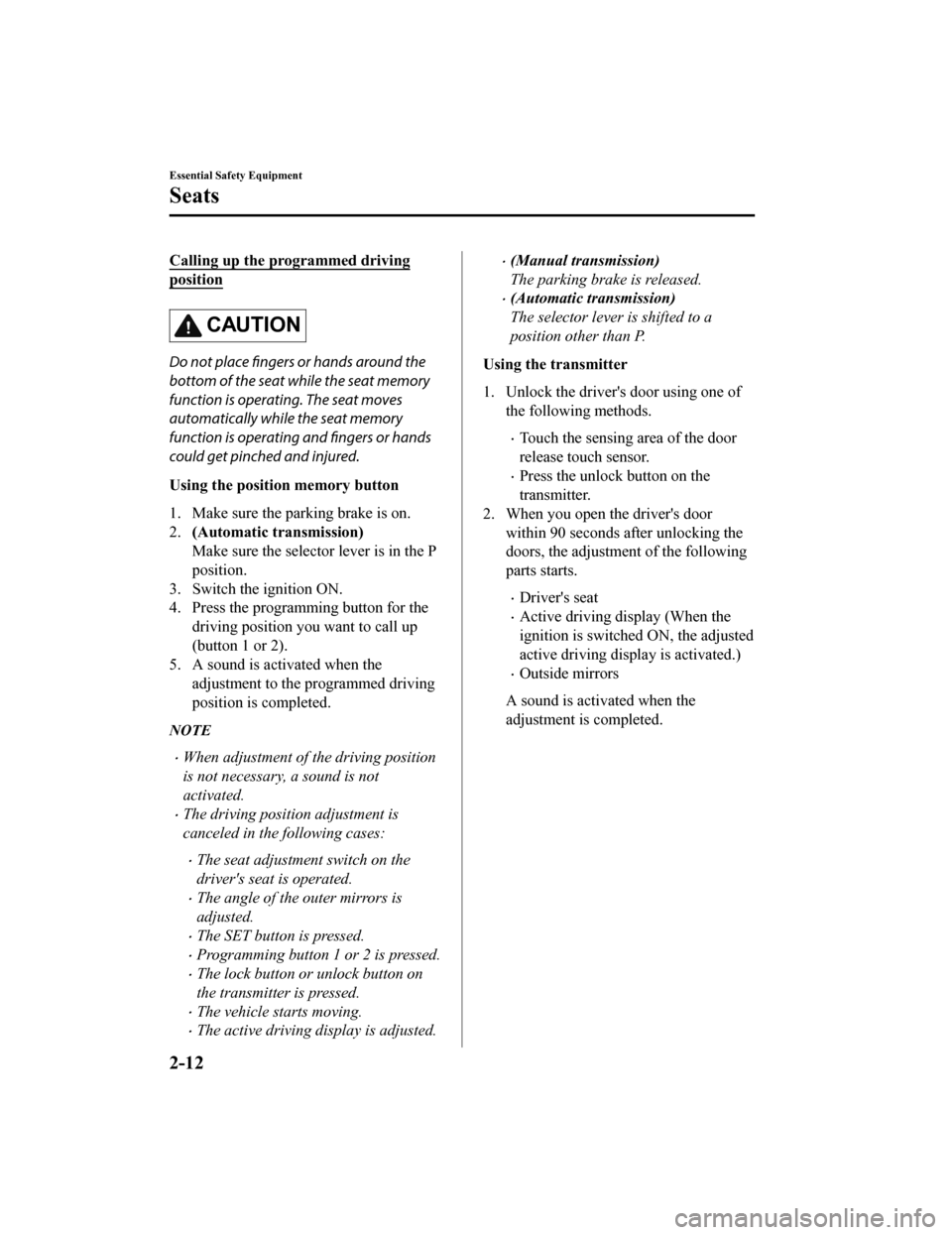
Calling up the programmed driving
position
CAUTION
Do not place fingers or hands around the
bottom of the seat while the seat memory
function is operating. The seat moves
automatically while the seat memory
function is operating and fingers or hands
could get pinched and injured.
Using the position memory button
1. Make sure the parking brake is on.
2. (Automatic transmission)
Make sure the selector lever is in the P
position.
3. Switch the ignition ON.
4. Press the programming button for the driving position you want to call up
(button 1 or 2).
5. A sound is activated when the adjustment to the programmed driving
position is completed.
NOTE
When adjustment of the driving position
is not necessary, a sound is not
activated.
The driving position adjustment is
canceled in the following cases:
The seat adjustment switch on the
driver's seat is operated.
The angle of the outer mirrors is
adjusted.
The SET button is pressed.
Programming button 1 or 2 is pressed.
The lock button or unlock button on
the transmitter is pressed.
The vehicle starts moving.
The active driving display is adjusted.
(Manual transmission)
The parking brake is released.
(Automatic transmission)
The selector lever is shifted to a
position other than P.
Using the transmitter
1. Unlock the driver's door using one of the following methods.
Touch the sensing area of the door
release touch sensor.
Press the unlock button on the
transmitter.
2. When you open the driver's door within 90 seconds after unlocking the
doors, the adjustment of the following
parts starts.
Driver's seat
Active driving display (When the
ignition is switched ON, the adjusted
active driving display is activated.)
Outside mirrors
A sound is activated when the
adjustment is completed.
Essential Safety Equipment
Seats
2-12
Mazda3_8HZ1-EA-19G_Edition1_old 2019-5-17 13:49:03
Page 29 of 598
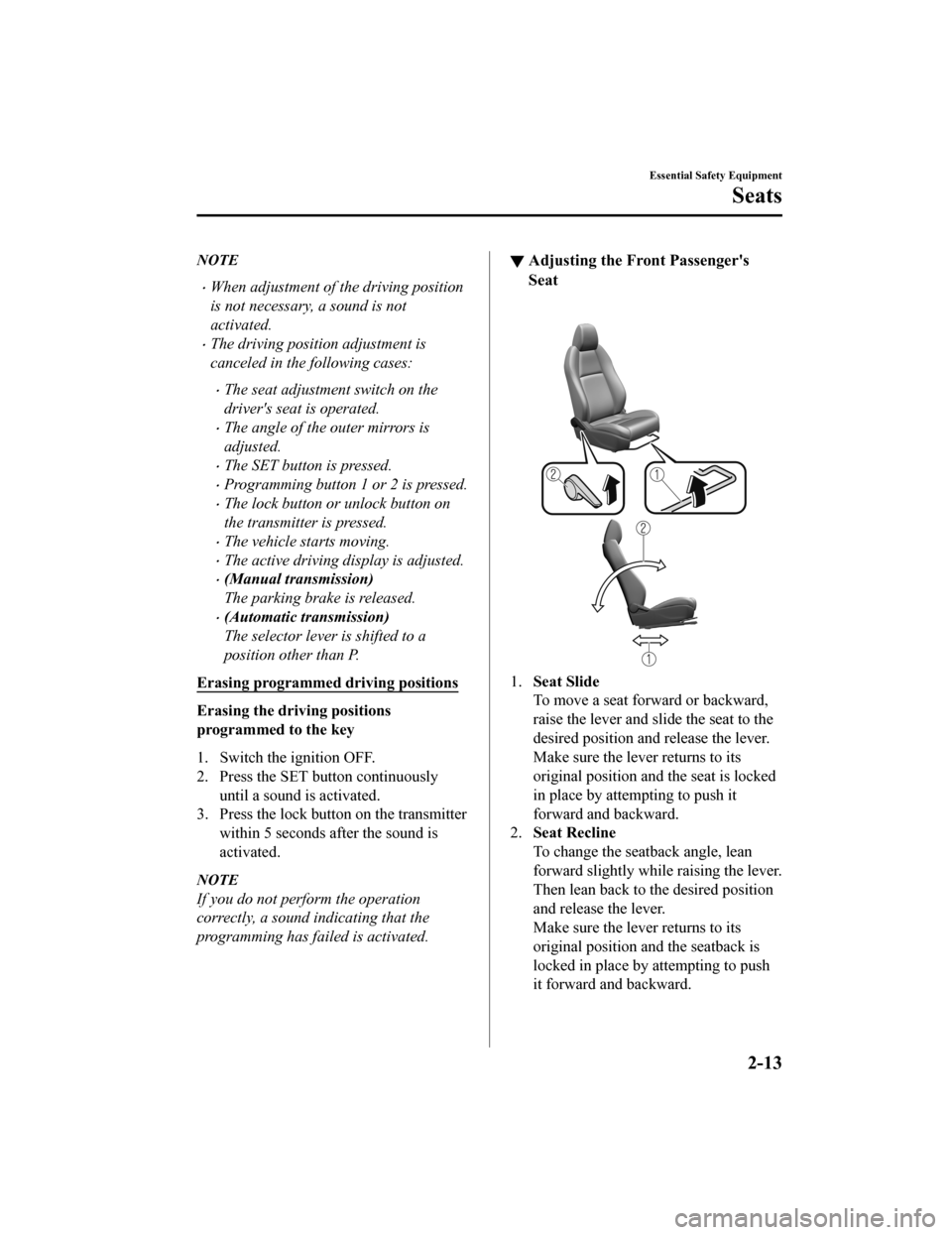
NOTE
When adjustment of the driving position
is not necessary, a sound is not
activated.
The driving position adjustment is
canceled in the following cases:
The seat adjustment switch on the
driver's seat is operated.
The angle of the outer mirrors is
adjusted.
The SET button is pressed.
Programming button 1 or 2 is pressed.
The lock button or unlock button on
the transmitter is pressed.
The vehicle starts moving.
The active driving display is adjusted.
(Manual transmission)
The parking brake is released.
(Automatic transmission)
The selector lever is shifted to a
position other than P.
Erasing programmed driving positions
Erasing the dr iving positions
programmed to the key
1. Switch the ignition OFF.
2. Press the SET button continuously
until a sound is activated.
3. Press the lock button on the transmitter
within 5 seconds after the sound is
activated.
NOTE
If you do not perform the operation
correctly, a sound indicating that the
programming has failed is activated.
▼Adjusting the Front Passenger's
Seat
1.
Seat Slide
To move a seat forwa rd or backward,
raise the lever and slide the seat to the
desired position and release the lever.
Make sure the lever returns to its
original position a nd the seat is locked
in place by attempting to push it
forward and backward.
2. Seat Recline
To change the seatback angle, lean
forward slightly while raising the lever.
Then lean back to the desired position
and release the lever.
Make sure the lever returns to its
original position a nd the seatback is
locked in place by attempting to push
it forward and backward.
Essential Safety Equipment
Seats
2-13
Mazda3_8HZ1-EA-19G_Edition1_old 2019-5-17 13:49:03
Page 37 of 598
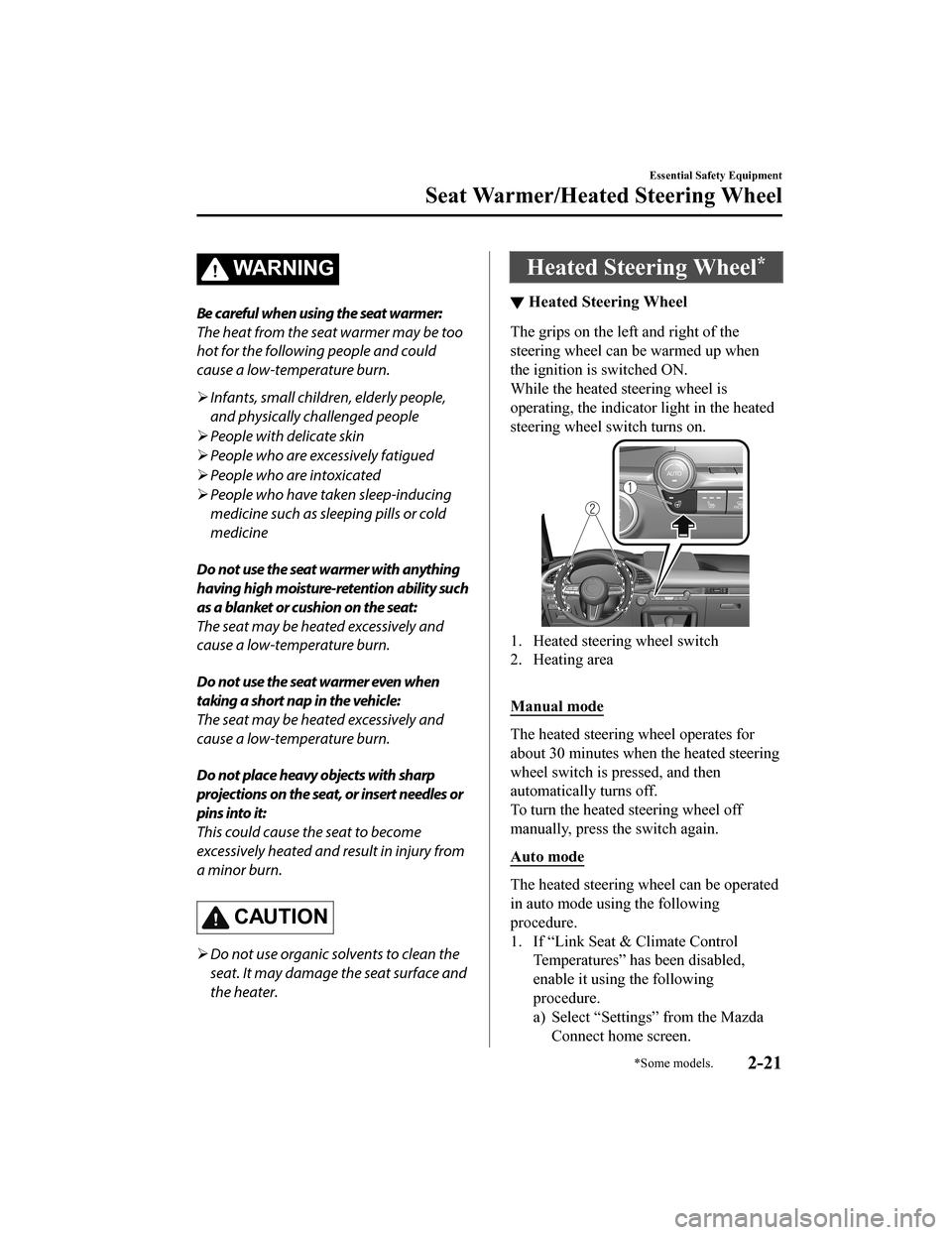
WA R N I N G
Be careful when using the seat warmer:
The heat from the seat warmer may be too
hot for the following people and could
cause a low-temperature burn.
Infants, small children, elderly people,
and physically challenged people
People with delicate skin
People who are excessively fatigued
People who are intoxicated
People who have taken sleep-inducing
medicine such as sleeping pills or cold
medicine
Do not use the seat warmer with anything
having high moisture-retention ability such
as a blanket or cushion on the seat:
The seat may be heated excessively and
cause a low-temperature burn.
Do not use the seat warmer even when
taking a short nap in the vehicle:
The seat may be heated excessively and
cause a low-temperature burn.
Do not place heavy objects with sharp
projections on the seat, or insert needles or
pins into it:
This could cause the seat to become
excessively heated and result in injury from
a minor burn.
CAUTION
Do not use organic solvents to clean the
seat. It may damage the seat surface and
the heater.
Heated Steering Wheel*
▼ Heated Steering Wheel
The grips on the left and right of the
steering wheel can be warmed up when
the ignition is switched ON.
While the heated steering wheel is
operating, the indicator light in the heated
steering wheel sw
itch turns on.
1. Heated steering wheel switch
2. Heating area
Manual mode
The heated steering wheel operates for
about 30 minutes when the heated steering
wheel switch is pressed, and then
automatically turns off.
To turn the heated steering wheel off
manually, press the switch again.
Auto mode
The heated steering wheel can be operated
in auto mode using the following
procedure.
1. If “Link Seat & Climate Control
Temperatures” has been disabled,
enable it using the following
procedure.
a) Select “Settings” from the Mazda
Connect home screen.
Essential Safety Equipment
Seat Warmer/Heated Steering Wheel
*Some models.2-21
Mazda3_8HZ1-EA-19G_Edition1_old 2019-5-17 13:49:03
Page 38 of 598
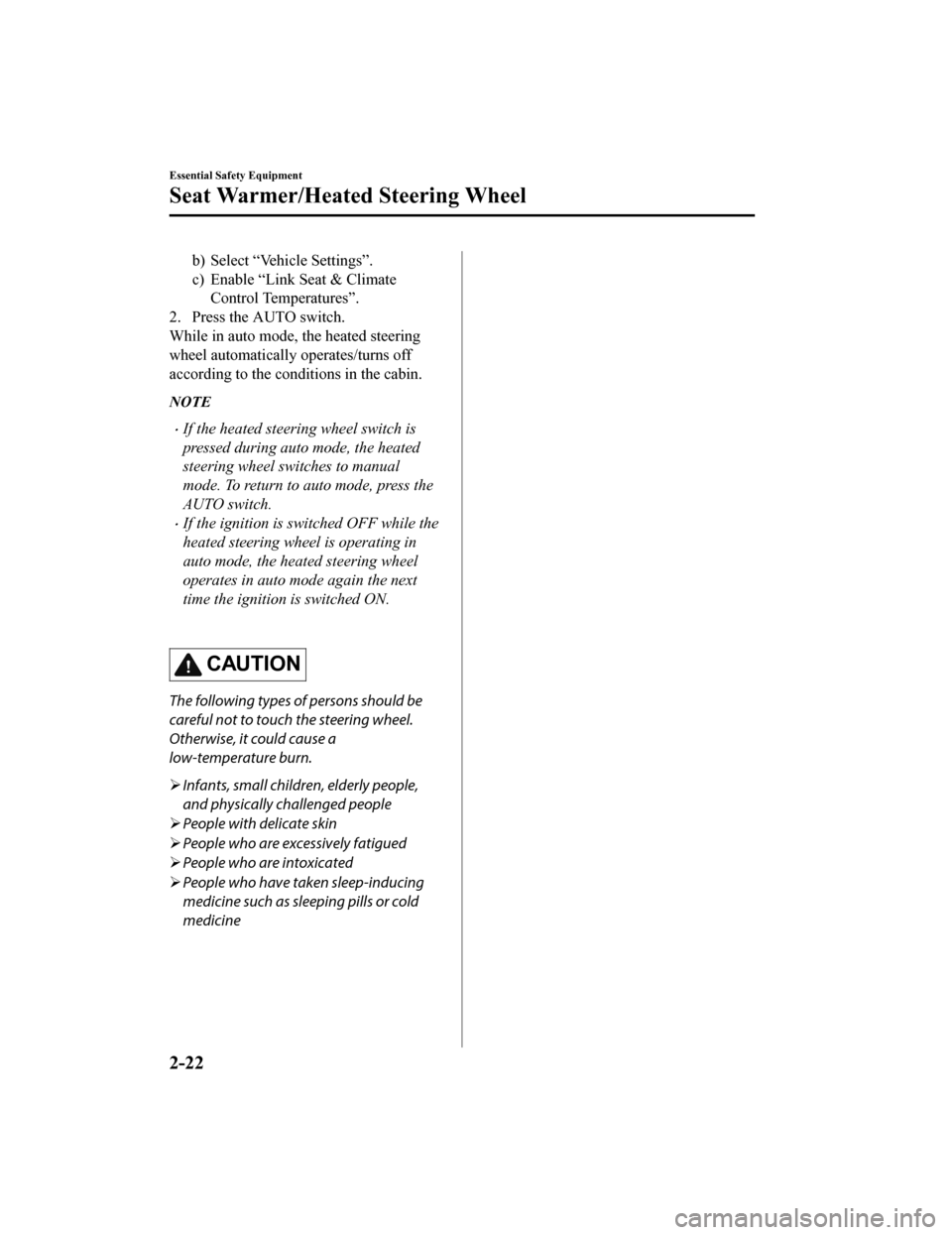
b) Select “Vehicle Settings”.
c) Enable “Link Seat & ClimateControl Temperatures”.
2. Press the AUTO switch.
While in auto mode, t he heated steering
wheel automatically o perates/turns off
according to the conditions in the cabin.
NOTE
If the heated steering wheel switch is
pressed during auto mode, the heated
steering wheel switches to manual
mode. To return to auto mode, press the
AUTO switch.
If the ignition is sw itched OFF while the
heated steering wheel is operating in
auto mode, the heated steering wheel
operates in auto mode again the next
time the ignition is switched ON.
CAUTION
The following types of persons should be
careful not to touch the steering wheel.
Otherwise, it could cause a
low-temperature burn.
Infants, small children, elderly people,
and physically challenged people
People with delicate skin
People who are excessively fatigued
People who are intoxicated
People who have taken sleep-inducing
medicine such as sleeping pills or cold
medicine
Essential Safety Equipment
Seat Warmer/Heated Steering Wheel
2-22
Mazda3_8HZ1-EA-19G_Edition1_old 2019-5-17 13:49:03
Page 43 of 598
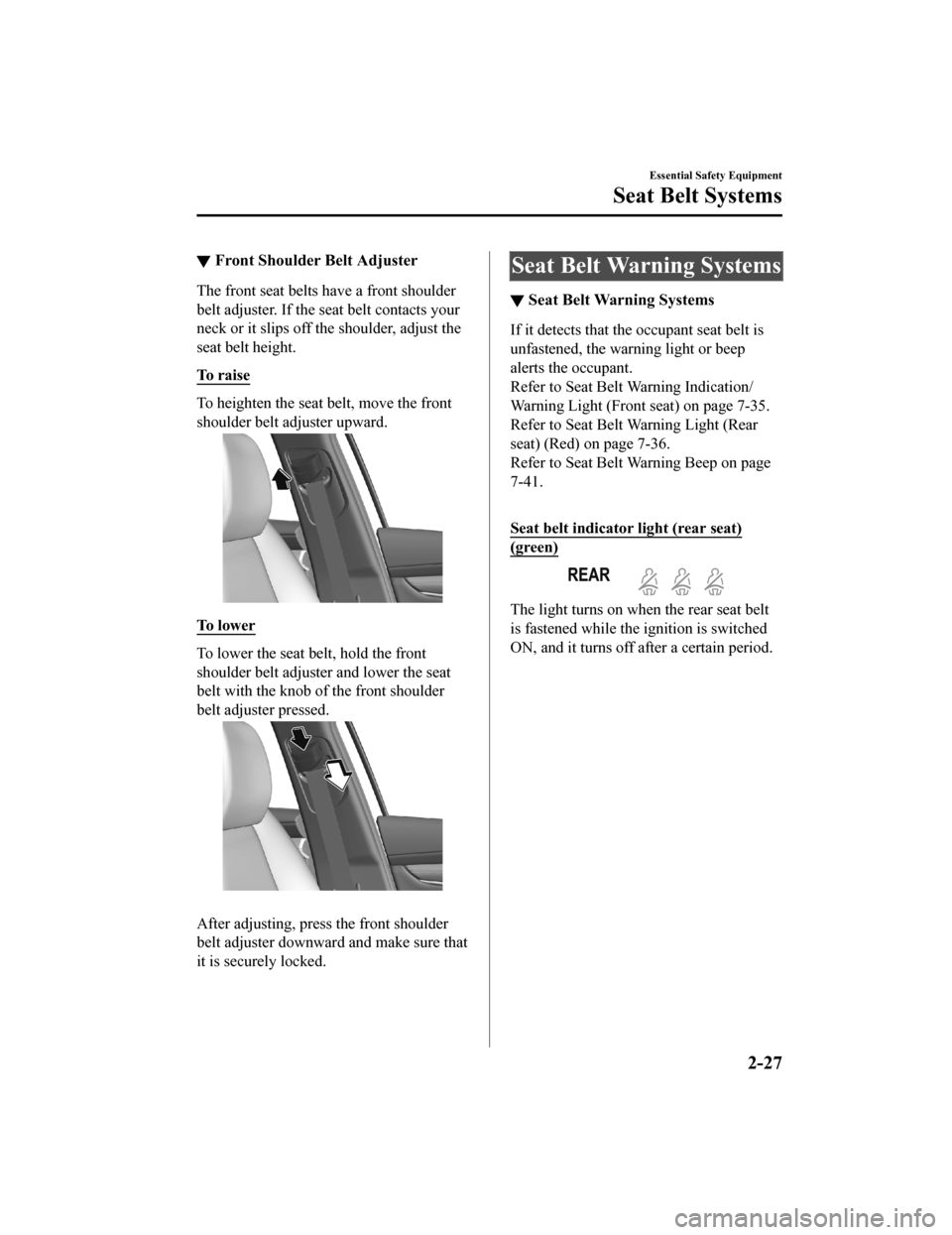
▼Front Shoulder Belt Adjuster
The front seat belts
have a front shoulder
belt adjuster. If the seat belt contacts your
neck or it slips off the shoulder, adjust the
seat belt height.
To r a i s e
To heighten the seat belt, move the front
shoulder belt adjuster upward.
To l o w e r
To lower the seat belt, hold the front
shoulder belt adjuster and lower the seat
belt with the knob of the front shoulder
belt adjuster pressed.
After adjusting, press the front shoulder
belt adjuster downward and make sure that
it is securely locked.
Seat Belt Warning Systems
▼ Seat Belt Warning Systems
If it detects that the occupant seat belt is
unfastened, the warning light or beep
alerts the occupant.
Refer to Seat Belt Wa
rning Indication/
Warning Light (Front seat) on page 7-35.
Refer to Seat Belt Warning Light (Rear
seat) (Red) on page 7-36.
Refer to Seat Belt Wa rning Beep on page
7-41.
Seat belt indicator light (rear seat)
(green)
The light turns on when the rear seat belt
is fastened while the ignition is switched
ON, and it turns off after a certain period.
Essential Safety Equipment
Seat Belt Systems
2-27
Mazda3_8HZ1-EA-19G_Edition1_old 2019-5-17 13:49:03
Page 64 of 598
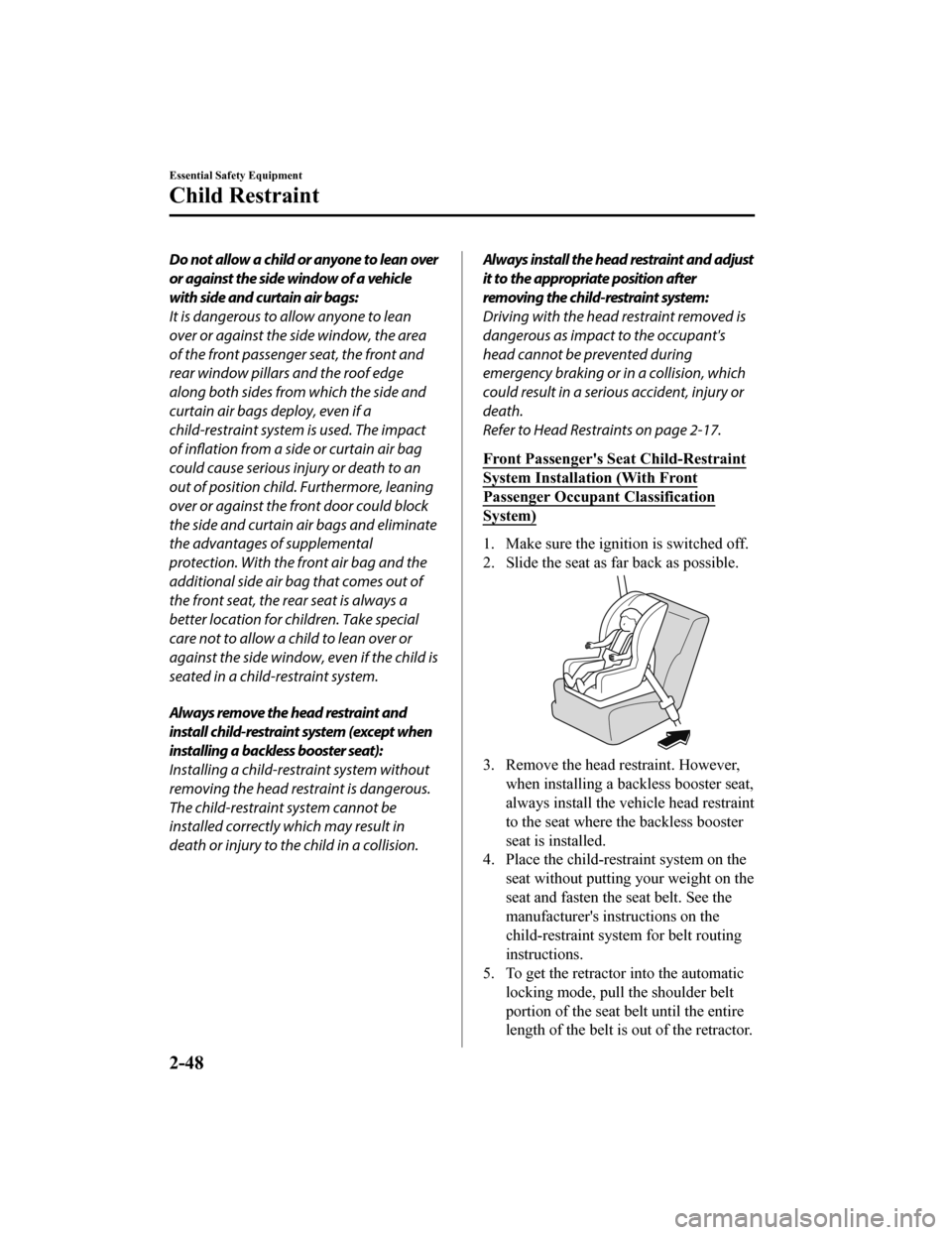
Do not allow a child or anyone to lean over
or against the side window of a vehicle
with side and curtain air bags:
It is dangerous to allow anyone to lean
over or against the side window, the area
of the front passenger seat, the front and
rear window pillars and the roof edge
along both sides from which the side and
curtain air bags deploy, even if a
child-restraint system is used. The impact
of inflation from a side or curtain air bag
could cause serious injury or death to an
out of position child. Furthermore, leaning
over or against the front door could block
the side and curtain air bags and eliminate
the advantages of supplemental
protection. With the front air bag and the
additional side air bag that comes out of
the front seat, the rear seat is always a
better location for children. Take special
care not to allow a child to lean over or
against the side window, even if the child is
seated in a child-restraint system.
Always remove the head restraint and
install child-restraint system (except when
installing a backless booster seat):
Installing a child-restraint system without
removing the head restraint is dangerous.
The child-restraint system cannot be
installed correctly which may result in
death or injury to the child in a collision.Always install the head restraint and adjust
it to the appropriate position after
removing the child-restraint system:
Driving with the head restraint removed is
dangerous as impact to the occupant's
head cannot be prevented during
emergency braking or in a collision, which
could result in a serious accident, injury or
death.
Refer to Head Restraints on page 2-17.
Front Passenger's Seat Child-Restraint
System Installation (With Front
Passenger Occupant Classification
System)
1. Make sure the ignition is switched off.
2. Slide the seat as fa r back as possible.
3. Remove the head restraint. However,
when installing a backless booster seat,
always install the vehicle head restraint
to the seat where the backless booster
seat is installed.
4. Place the child-restraint system on the
seat without putting your weight on the
seat and fasten the seat belt. See the
manufacturer's instructions on the
child-restraint syst em for belt routing
instructions.
5. To get the retractor into the automatic locking mode, pull the shoulder belt
portion of the seat belt until the entire
length of the belt is out of the retractor.
Essential Safety Equipment
Child Restraint
2-48
Mazda3_8HZ1-EA-19G_Edition1_old 2019-5-17 13:49:03
Page 65 of 598
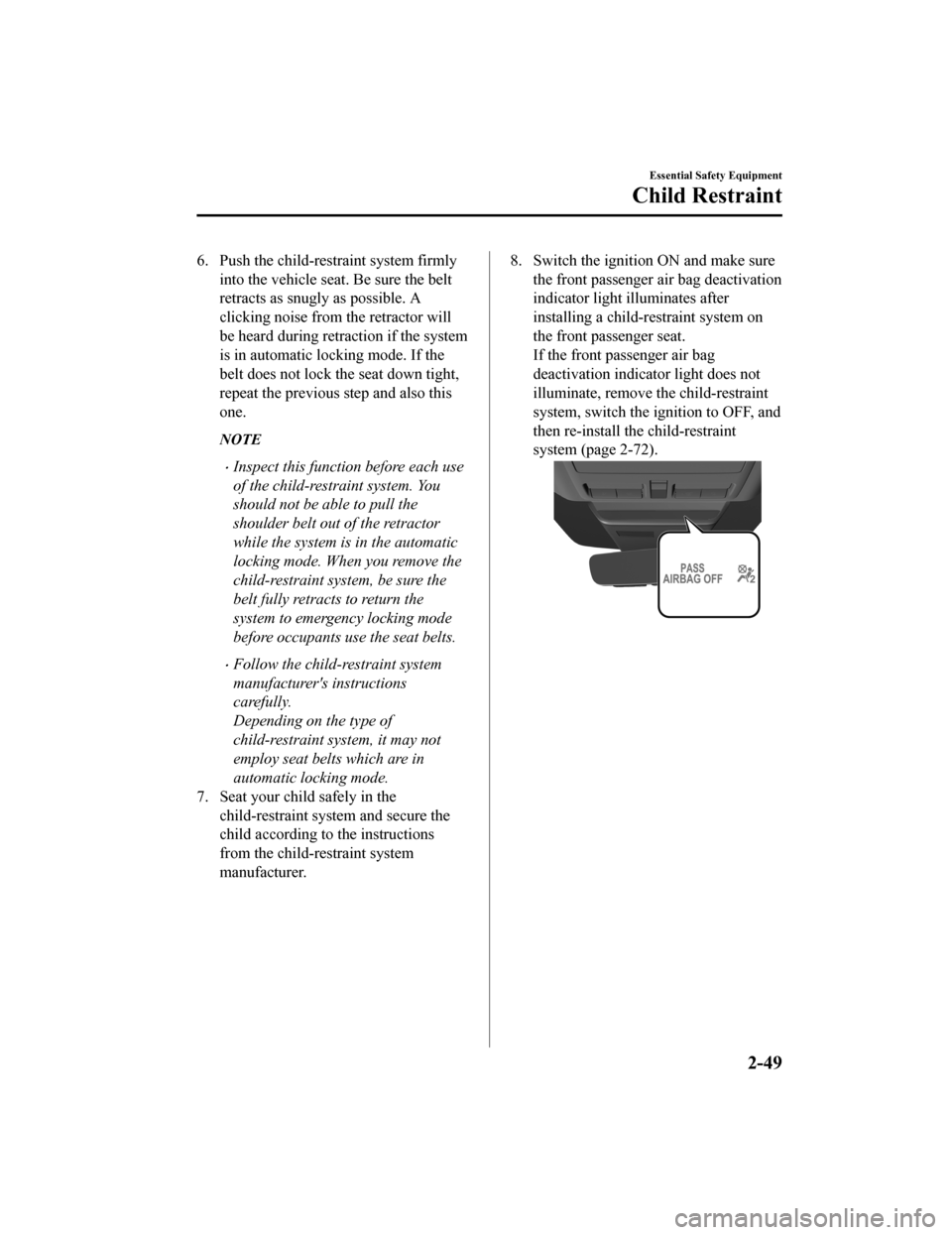
6. Push the child-restraint system firmlyinto the vehicle seat. Be sure the belt
retracts as snugly as possible. A
clicking noise from the retractor will
be heard during retraction if the system
is in automatic locking mode. If the
belt does not lock the seat down tight,
repeat the previous step and also this
one.
NOTE
Inspect this function before each use
of the child-rest raint system. You
should not be able to pull the
shoulder belt out of the retractor
while the system is in the automatic
locking mode. When you remove the
child-restraint system, be sure the
belt fully retracts to return the
system to emergency locking mode
before occupants use the seat belts.
Follow the child- restraint system
manufacturer's instructions
carefully.
Depending on the type of
child-restraint sy stem, it may not
employ seat belts which are in
automatic locking mode.
7. Seat your child safely in the
child-restraint sy stem and secure the
child according to the instructions
from the child-restraint system
manufacturer.
8. Switch the ignition ON and make sure the front passenger air bag deactivation
indicator light illuminates after
installing a child-restraint system on
the front passenger seat.
If the front passenger air bag
deactivation indicator light does not
illuminate, remove the child-restraint
system, switch the i gnition to OFF, and
then re-install th e child-restraint
system (page 2-72).
Essential Safety Equipment
Child Restraint
2-49
Mazda3_8HZ1-EA-19G_Edition1_old 2019-5-17 13:49:03
Page 72 of 598
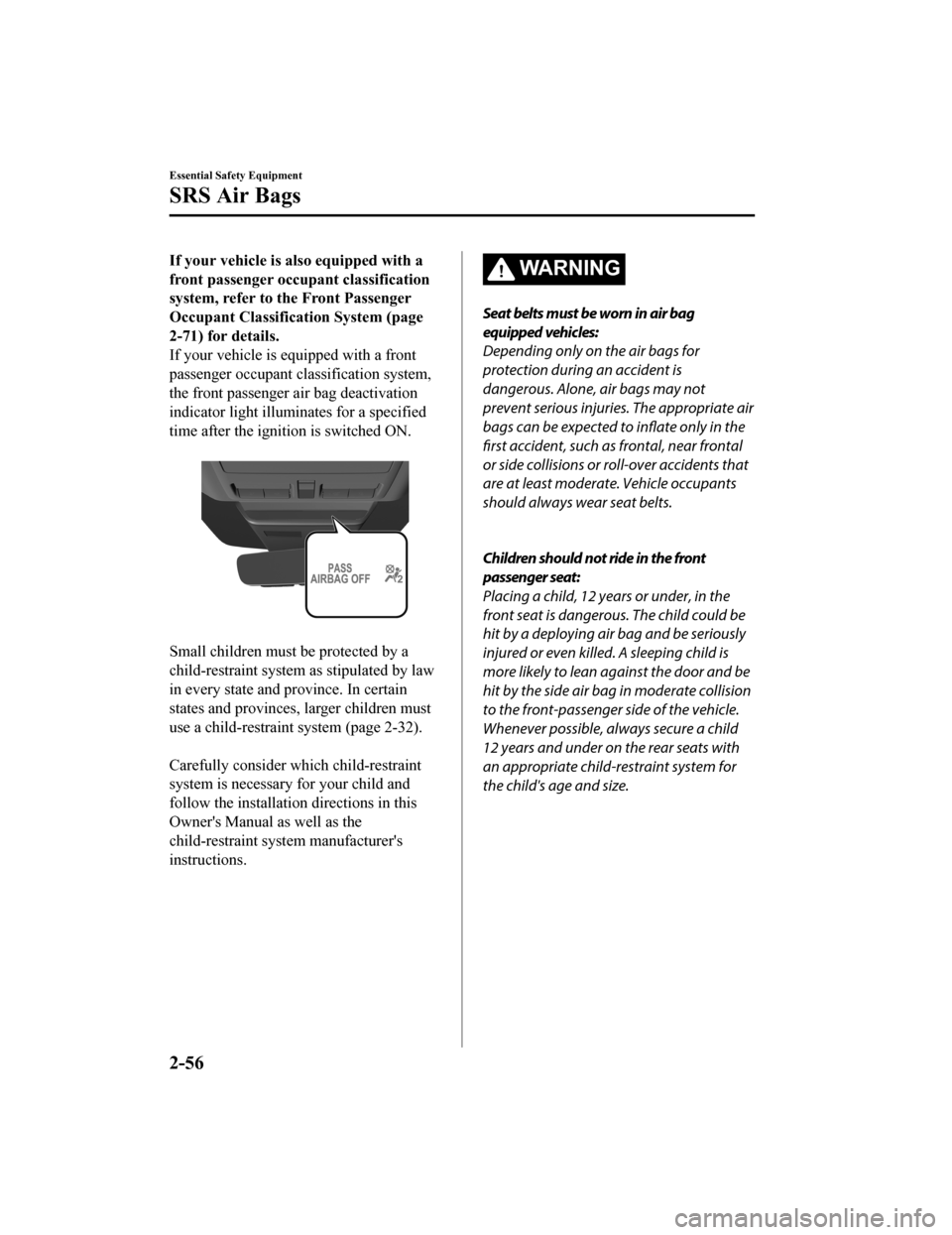
If your vehicle is also equipped with a
front passenger occupant classification
system, refer to the Front Passenger
Occupant Classification System (page
2-71) for details.
If your vehicle is equipped with a front
passenger occupant classification system,
the front passenger air bag deactivation
indicator light illuminates for a specified
time after the ignition is switched ON.
Small children must be protected by a
child-restraint system as stipulated by law
in every state and province. In certain
states and provinces, larger children must
use a child-restraint system (page 2-32).
Carefully consider wh ich child-restraint
system is necessary for your child and
follow the installation directions in this
Owner's Manual as well as the
child-restraint syst em manufacturer's
instructions.
WA R N I N G
Seat belts must be worn in air bag
equipped vehicles:
Depending only on the air bags for
protection during an accident is
dangerous. Alone, air bags may not
prevent serious injuries. The appropriate air
bags can be expected to inflate only in the
first accident, such as frontal, near frontal
or side collisions or roll-over accidents that
are at least moderate. Vehicle occupants
should always wear seat belts.
Children should not ride in the front
passenger seat:
Placing a child, 12 years or under, in the
front seat is dangerous. The child could be
hit by a deploying air bag and be seriously
injured or even killed. A sleeping child is
more likely to lean against the door and be
hit by the side air bag in moderate collision
to the front-passenger side of the vehicle.
Whenever possible, always secure a child
12 years and under on the rear seats with
an appropriate child-restraint system for
the child's age and size.
Essential Safety Equipment
SRS Air Bags
2-56
Mazda3_8HZ1-EA-19G_Edition1_old 2019-5-17 13:49:03
Page 88 of 598
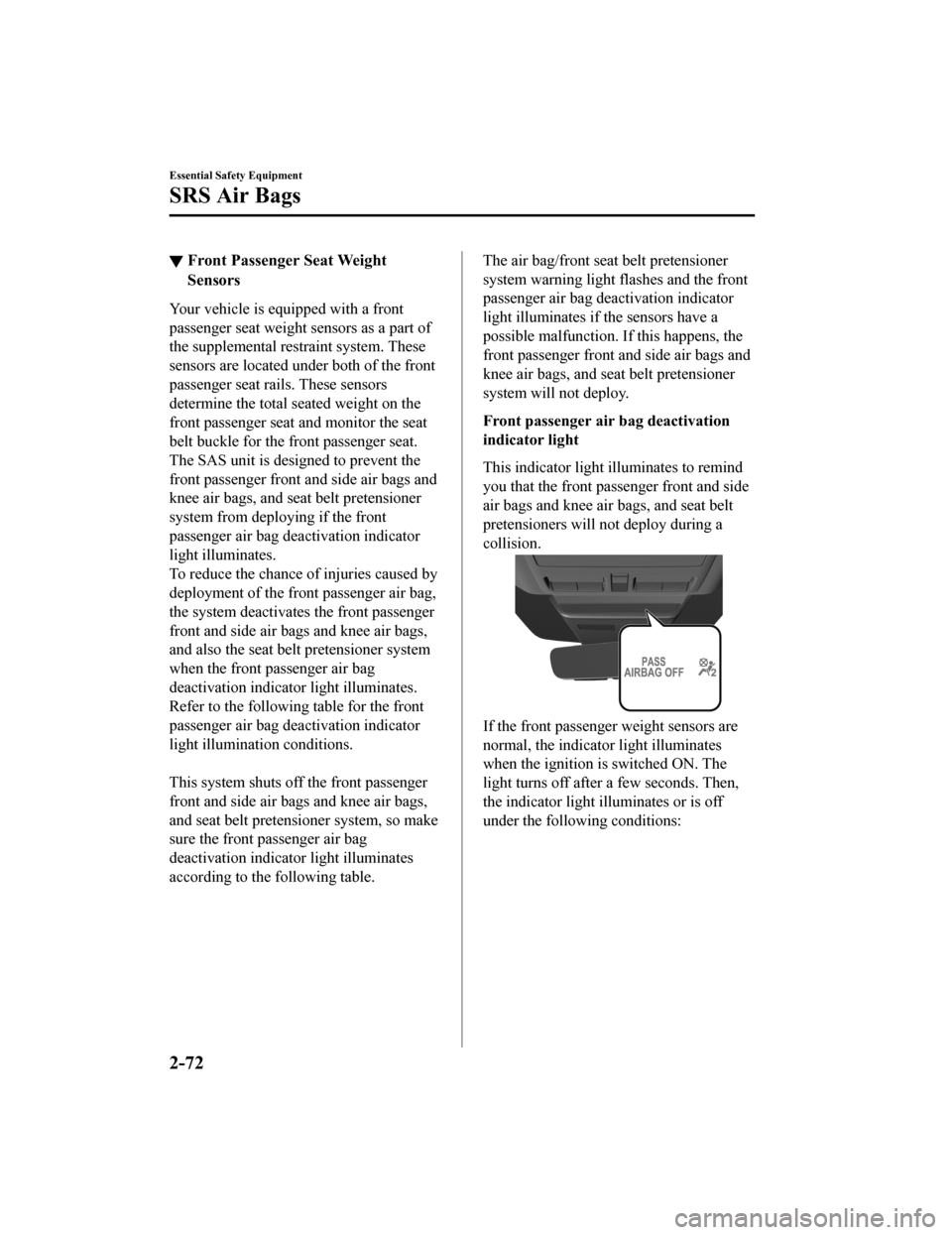
▼Front Passenger Seat Weight
Sensors
Your vehicle is equipped with a front
passenger seat weight sensors as a part of
the supplemental restraint system. These
sensors are located under both of the front
passenger seat rails. These sensors
determine the total
seated weight on the
front passenger seat and monitor the seat
belt buckle for the front passenger seat.
The SAS unit is designed to prevent the
front passenger front and side air bags and
knee air bags, and seat belt pretensioner
system from deploying if the front
passenger air bag deactivation indicator
light illuminates.
To reduce the chance of injuries caused by
deployment of the fr ont passenger air bag,
the system deactivates the front passenger
front and side air bags and knee air bags,
and also the seat belt pretensioner system
when the front passenger air bag
deactivation indicator light illuminates.
Refer to the following table for the front
passenger air bag deactivation indicator
light illumination conditions.
This system shuts off the front passenger
front and side air bags and knee air bags,
and seat belt pretensioner system, so make
sure the front passenger air bag
deactivation indicator light illuminates
according to the following table.
The air bag/front seat belt pretensioner
system warning light flashes and the front
passenger air bag deactivation indicator
light illuminates if the sensors have a
possible malfunction. If this happens, the
front passenger front and side air bags and
knee air bags, and seat belt pretensioner
system will not deploy.
Front passenger air bag deactivation
indicator light
This indicator light illuminates to remind
you that the front passenger front and side
air bags and knee air bags, and seat belt
pretensioners will not deploy during a
collision.
If the front passenger weight sensors are
normal, the indicator light illuminates
when the ignition is switched ON. The
light turns off after a few seconds. Then,
the indicator light illuminates or is off
under the following conditions:
Essential Safety Equipment
SRS Air Bags
2-72
Mazda3_8HZ1-EA-19G_Edition1_old 2019-5-17 13:49:03